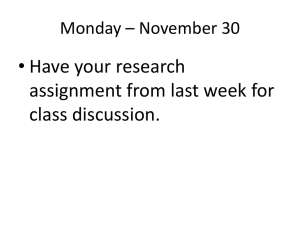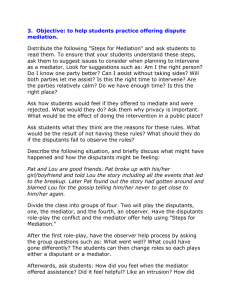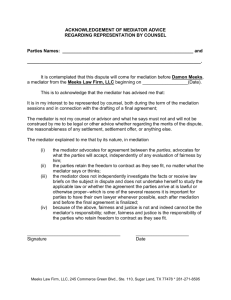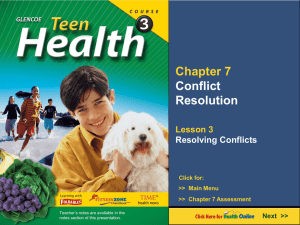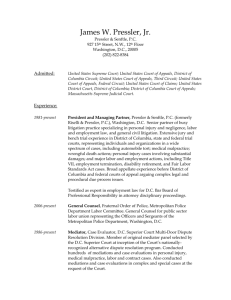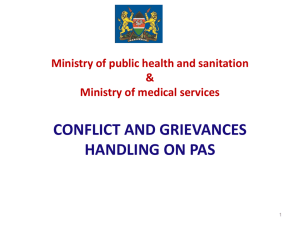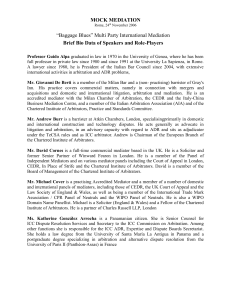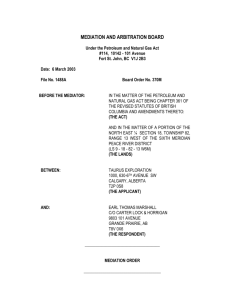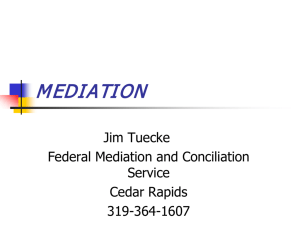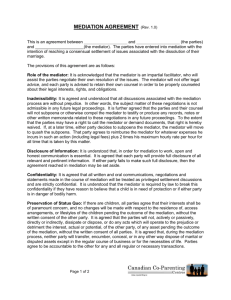4. Settling Disputes
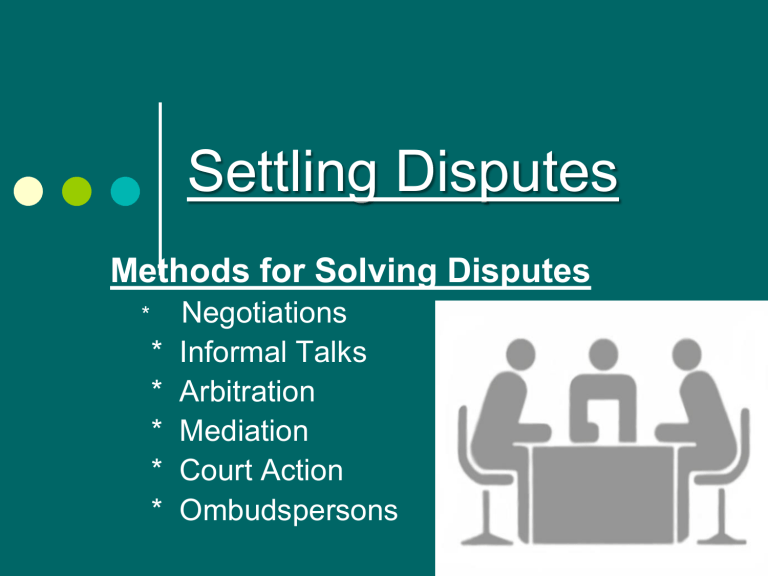
Settling Disputes
Methods for Solving Disputes
*
Negotiations
* Informal Talks
* Arbitration
* Mediation
* Court Action
* Ombudspersons
Usual Negotiations
Negotiations
(example: contract negotiations)
The process by which people involved in a dispute discuss their problem and try to reach a solution acceptable to all.
Work towards a “Win-Win” solution
Settlement: When attorneys work out an agreement before the case goes to trial
• Phase One: All involved come in with a sincere interest in finding a solution
• Phase Two: The actual negotiations (identify the real issue that needs to be resolved)
• Phase Three: Agree on what people outside the decision should be told
Outcome is legally binding
Informal Talk
(2 brothers are arguing over who gets the car this weekend)
•
•
•
Individuals involved talk directly with each other
Idea is not to win but to come to an agreement that serves both parties
Most conflicts can be solved this way of parties involved want to come to a mutually beneficial outcome
Arbitration
(example: property disputes in a divorce)
All parties agree to have one or more people listen to their arguments and make the decision for them.
Arbitrator is like a judge but less formal
All parties agree to abide by the ruling
(legally binding)
Mediation
(example: dispute at work between 2 co-workers)
When a third person helps the disputing parties talk about their problems and settle their differences
Relies on the willingness of the parties to come up with a reasonable settlement
Both need to agree to abide by the outcome
Steps in a Mediation Session
(read p.45)
Step One : Introduction: Mediator helps people involved feel at ease and establishes ground rules of behavior
Step Two : Telling the Story: Each person tells what happened. No interruptions are allowed
Step Three : Identifying Positions and Interests: Mediator makes sure each side was heard by summarizing each person’s views and asking questions.
Step Four : Identifying Alternative Solutions: The disputants think of possible solutions to the problem. The mediator makes a list and asks each to explain how they feel about each solution.
Step Five : Revising and Discussing Solutions: Based on the feelings of those involved, the mediator may help by suggesting changes/offering a better solutions.
Step Six : Reaching an Agreement: The mediator helps the sides reach an agreement. The agreement is written down. The disputants also discuss what happens if they find the agreement isn’t working for them or one chooses not to follow the agreement.
Current “Mediations” in news
Washington State workers
NFL / Referee lockout
Iran / Israel
Boeing / SPEA
Methods of Dispute Resolution
1. Less Formal
2. Just the disputants settle things
3. Not legally binding
4. More Formal
5. Many People Involved
6. Enforceable by courts
____ & ____ Arbitration
____ & ____ Court Action
____ & ____ Informal Talk
____ & ____ Mediation
____ & ____ Negotiations
On the back of this page, write a ½ to 1 page dialogue/example of a conflict being resolved using one of these methods that you may have experienced (or wish you did)
Examine the following situations and decide the best method for solving each problem.
( I nformal D iscussion, N egotiations, A rbitration, M ediation,
C ourt A ction, etc)
1)
2)
3)
4)
5)
6)
7)
Two sisters share a room. However, they disagree over how the room should be arranged and decorated.
A new stereo breaks down after two weeks, and the salesperson refuses to fix it.
A landlord will not make needed repairs because he believes the tenant caused the damage.
A labor union and an employer disagree over the wages and conditions of employment.
A married couple wants a divorce
The IRS sends you a letter claiming that you owe another
$200 in taxes. You disagree.
Carl invites Raquel to the prom, and she agrees to go with him. Then Miguel invites her to the prom. Raquel really wants to go with Miguel and accepts his invitation. Carl finds out about her decision after he has purchased flowers and paid of r a limousine to take them to the prom.
Ombudspersons
(example: Child Advocate in court)
Government agencies, newspapers and some universities use ombudspersons
A person who has the power to investigate complaints and then help the parties reach some agreement
If court ordered, is legally binding
If not, all parties have to agree to abide by the outcome
Problems at the Mall
Magda, David and Rashida have been friends since the sixth grade. One of their favorite activities is to go to the mall and look around in the stores. Sometimes they make purchases and sometimes they are just window-shopping. There are lots of young people who do this, and it is fun to see people and hang out
Recently, a number of stores in the mall have experienced an increase in shoplifting and vandalism. As a result, the stores have made a policy that no one under 16 years of age can enter without a parent or guardian. The new rues also state that if you are between the ages of 16-18 you cannot enter the store in groups larger than two. Other teens have to wait outside until each pair leaves. Store owners have threatened to call the police if the young people give them any trouble about the new policies.
This policy makes Magda, David and Rashida angry. They believe it is unfair. After all, they are paying customers and spend money in these stores. Why is the rule directed only at young people? They do not want to get into trouble with the police, but they do not understand why they have to be treated as troublemakers when they have not done anything wrong.
The manager of the shopping mall, along with one of the store owners, has agreed to meet with two of the teens and a mediator to try to find some workable solution.
Problems as the Mall
In preparation for the mediation session, the disputants should consider the following issues: a. What are your concerns? How would you state the issue in the dispute?
b. What is your starting position (demand)? What are your underlying interests (what do you really want)?
c. What is the best conceivable outcome from your perspective?
d. What do you think the starting position and underlying interests of the other side will be?
e. Identify two workable solutions that would solve the conflict
Use the list of Steps in a Typical Medication Session on p. 43 to walk through the process and develop a reasonable solution for the disputants.
Key to Success
Ideas for resolving the conflict come from the people who have the conflict
Those involved take responsibility for their role and work toward resolution
Quick Review
Methods of Resolving Disputes
Negotiations
Arbitration
Court Action
Informal Talks
Mediation
Ombudsperson
